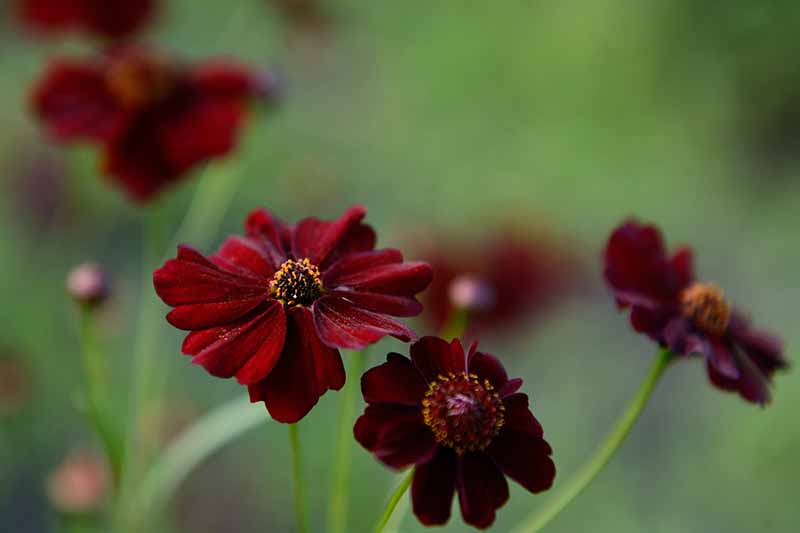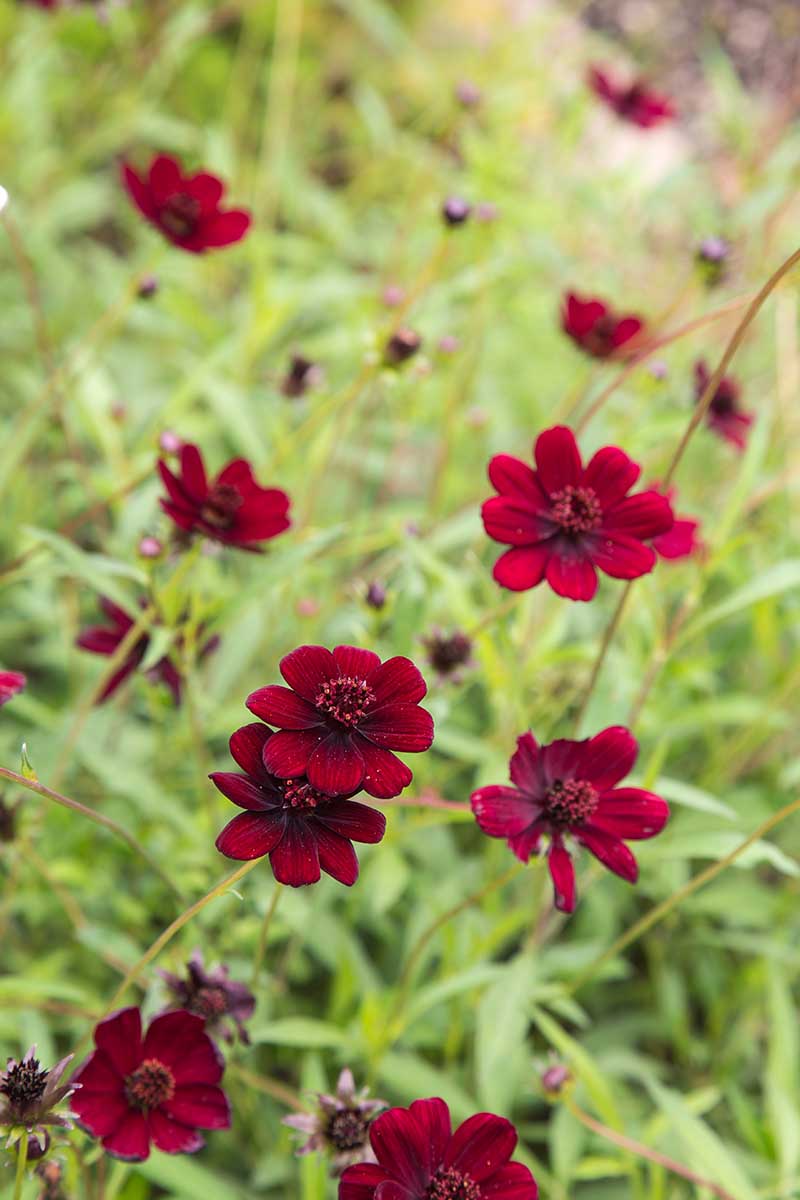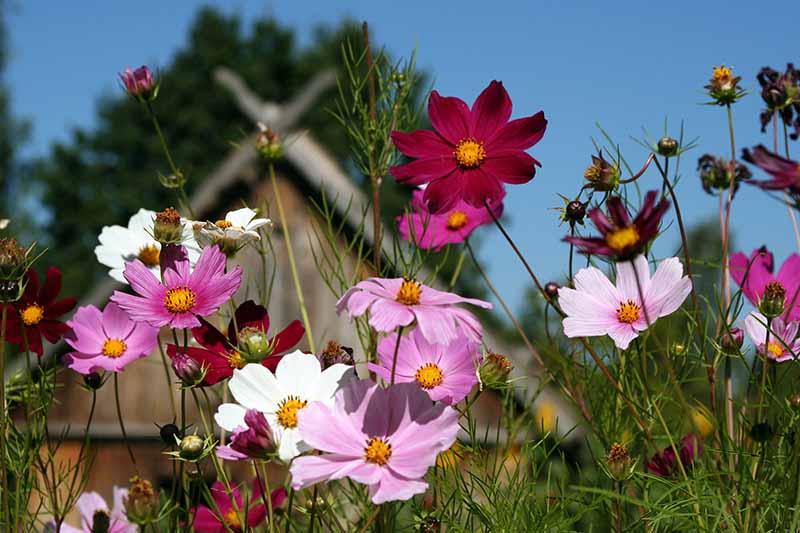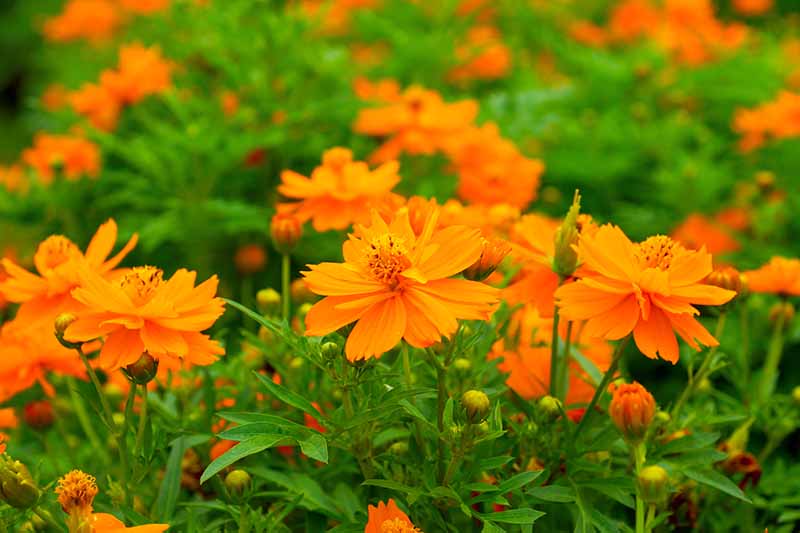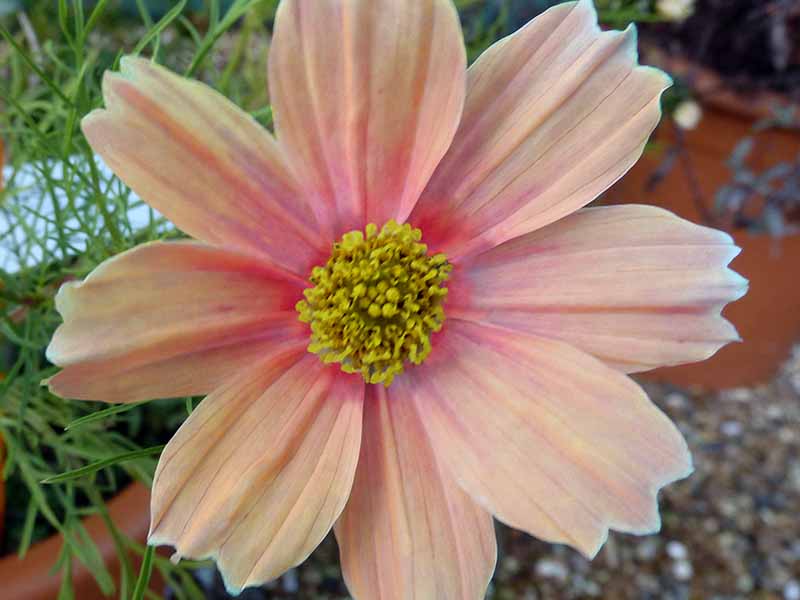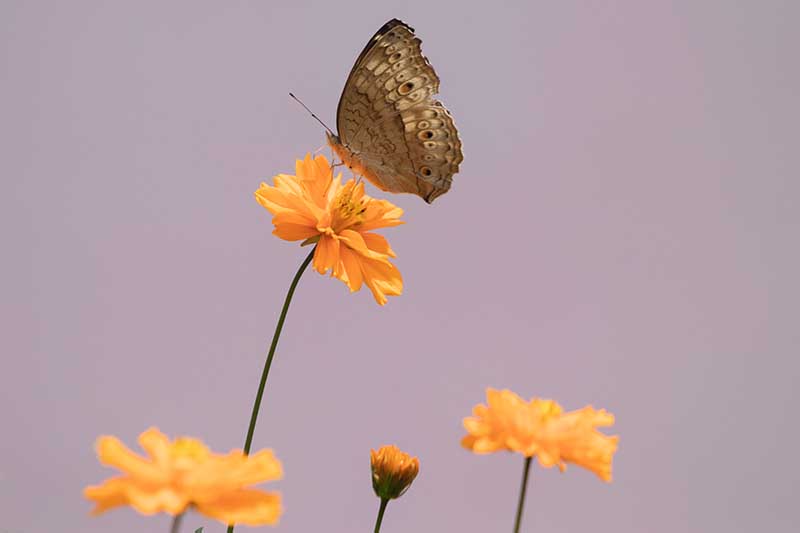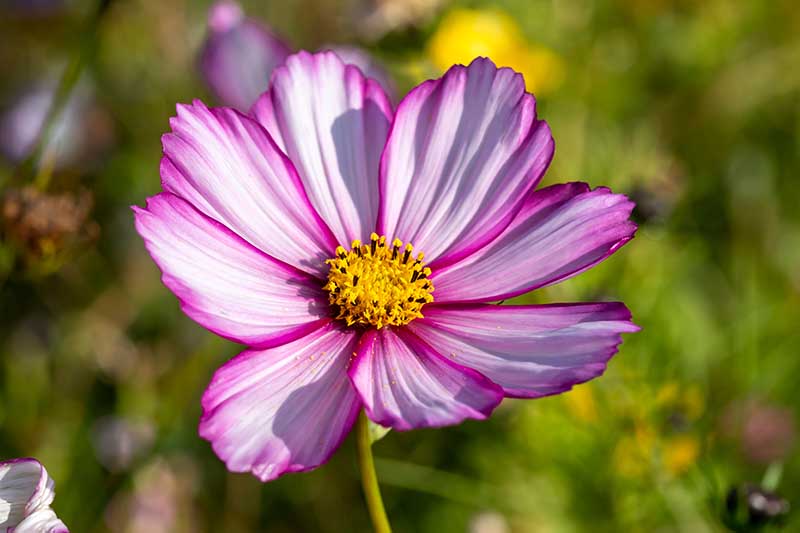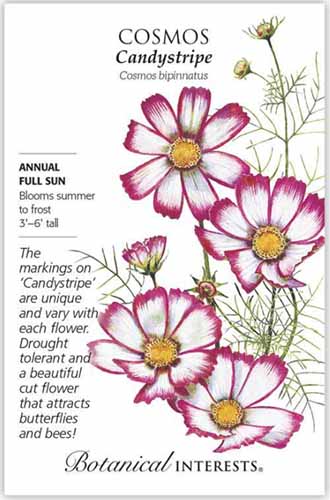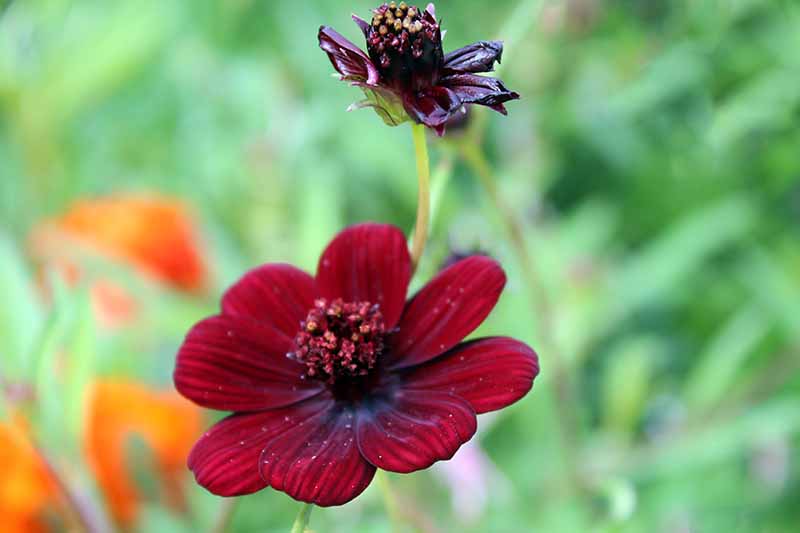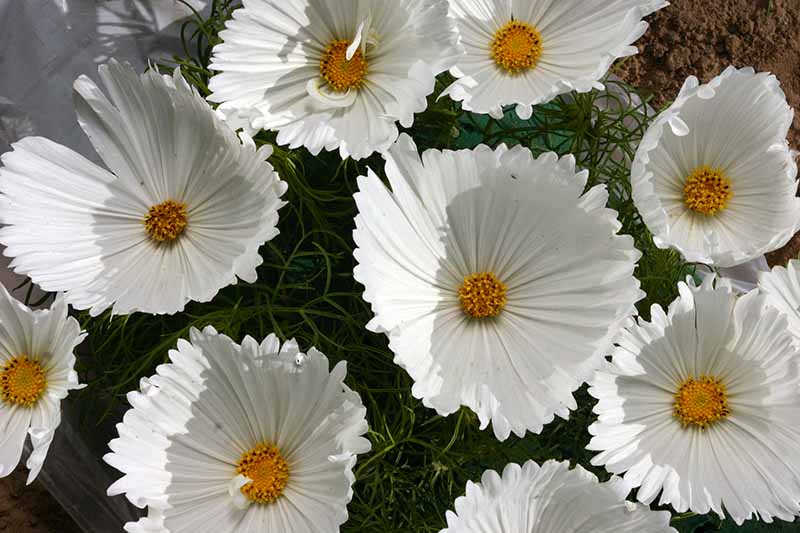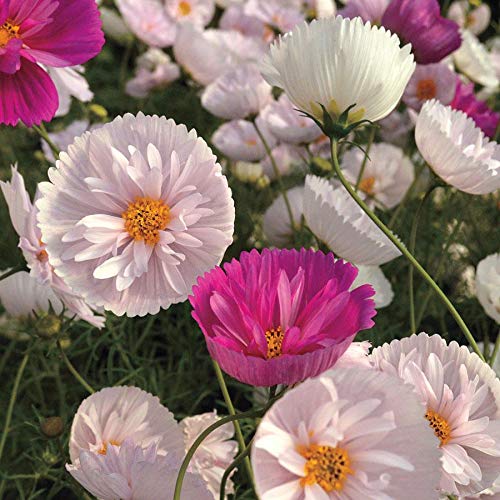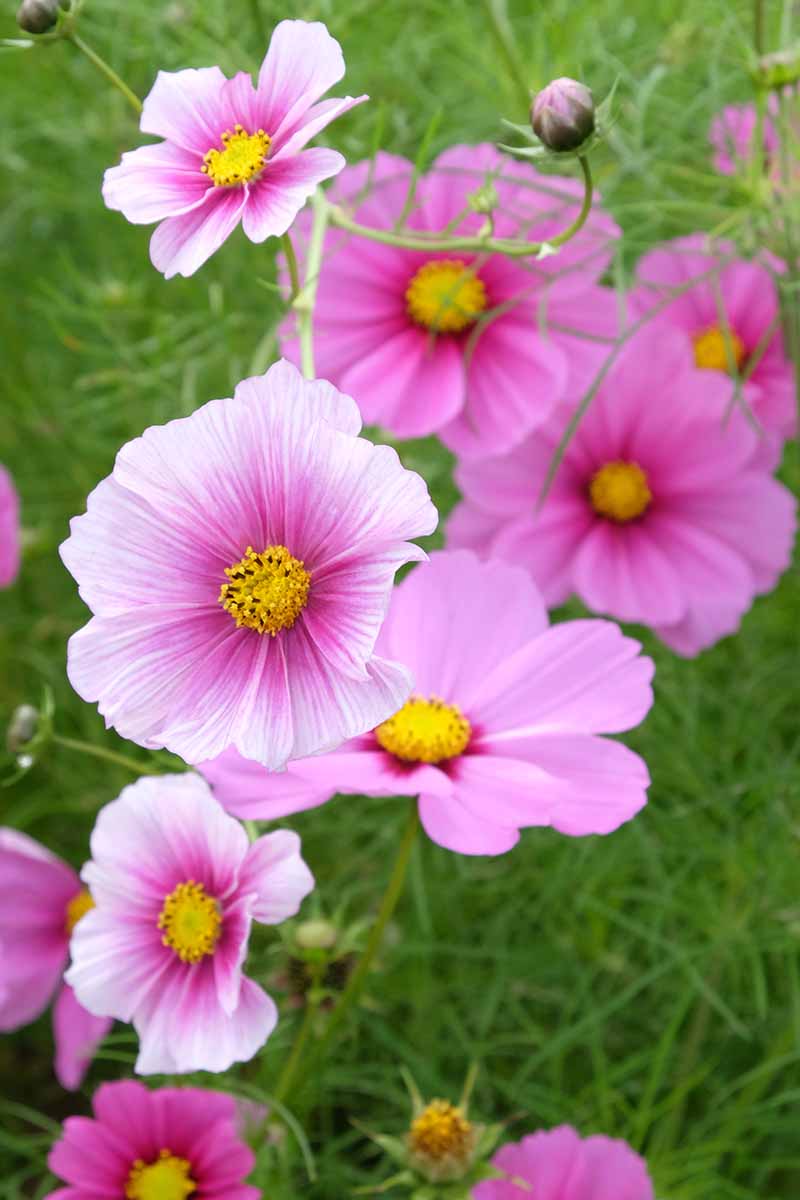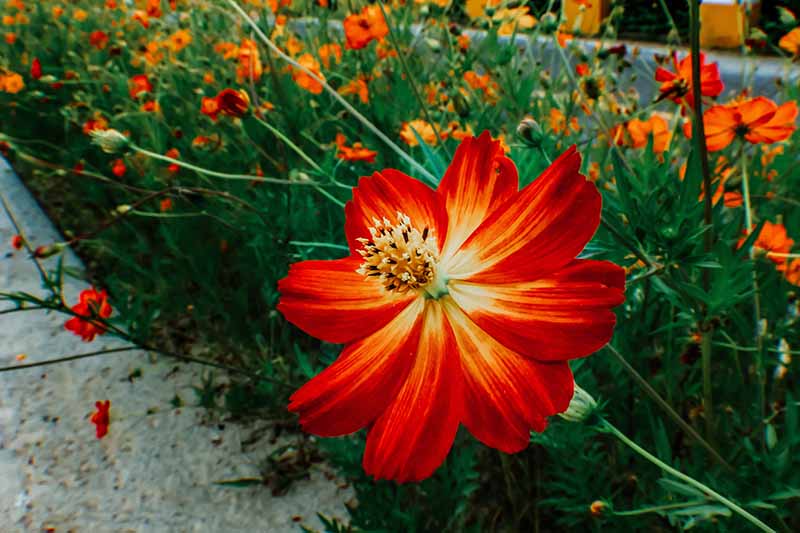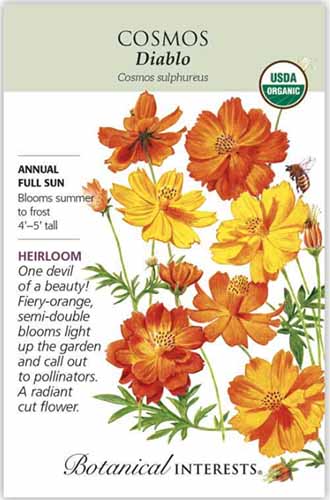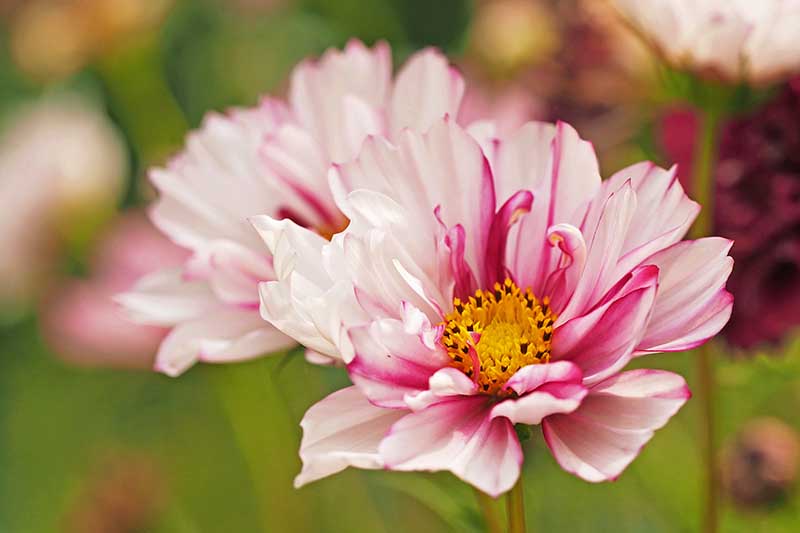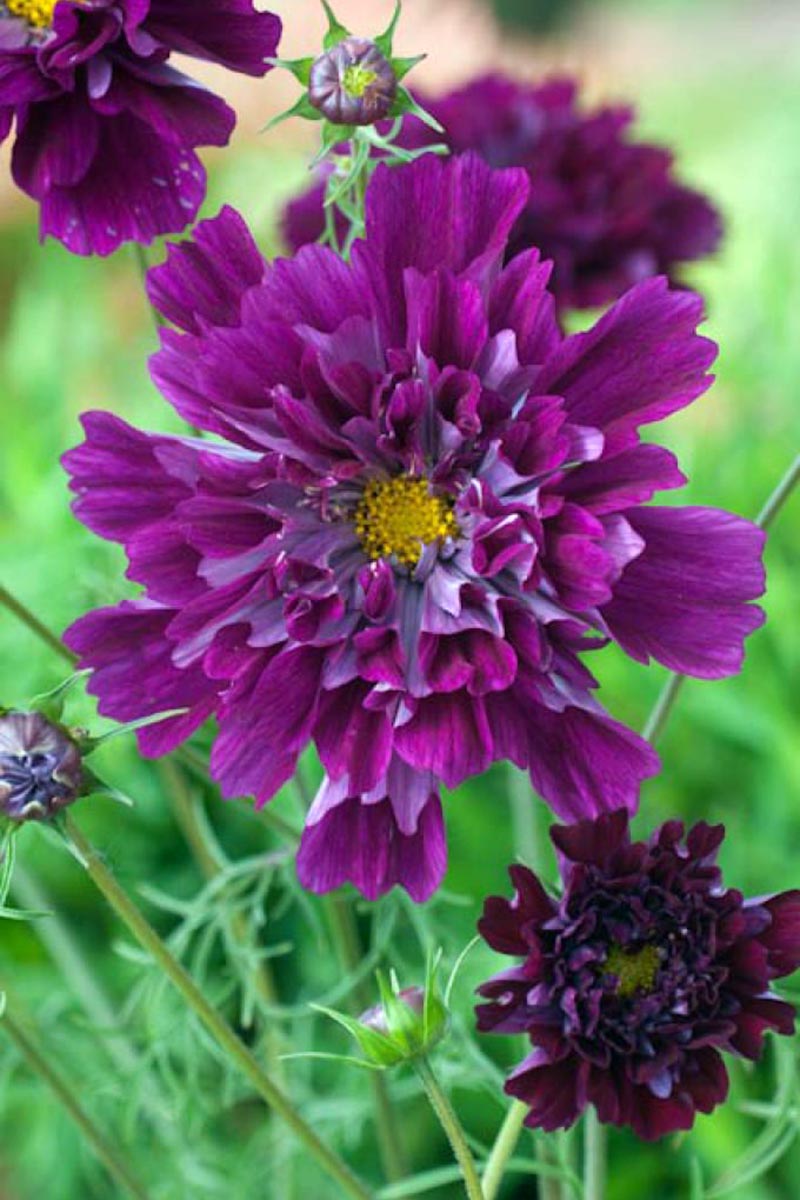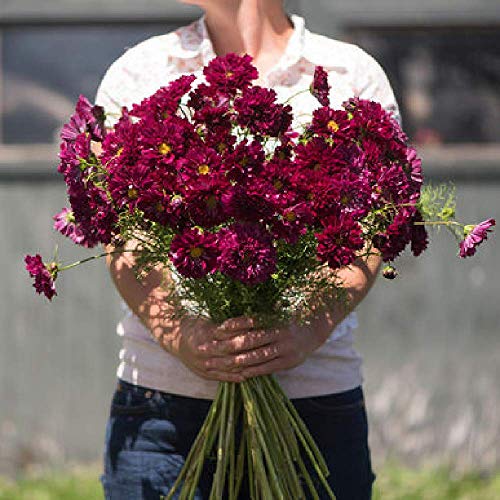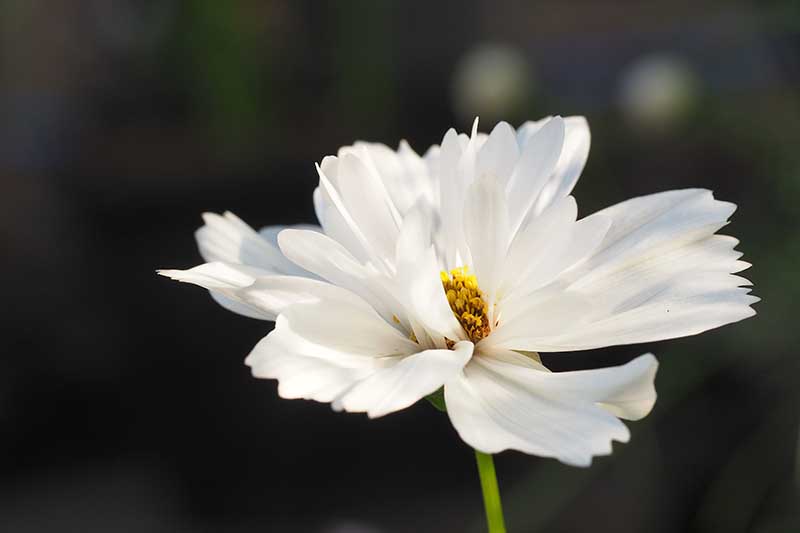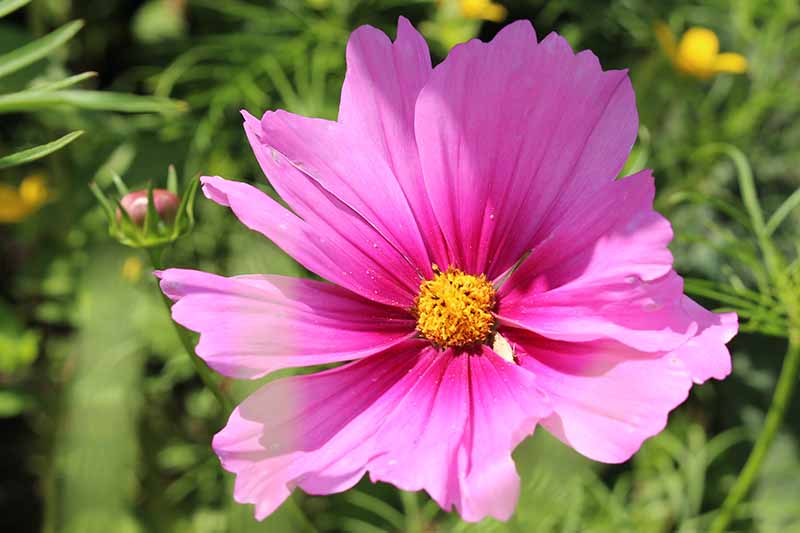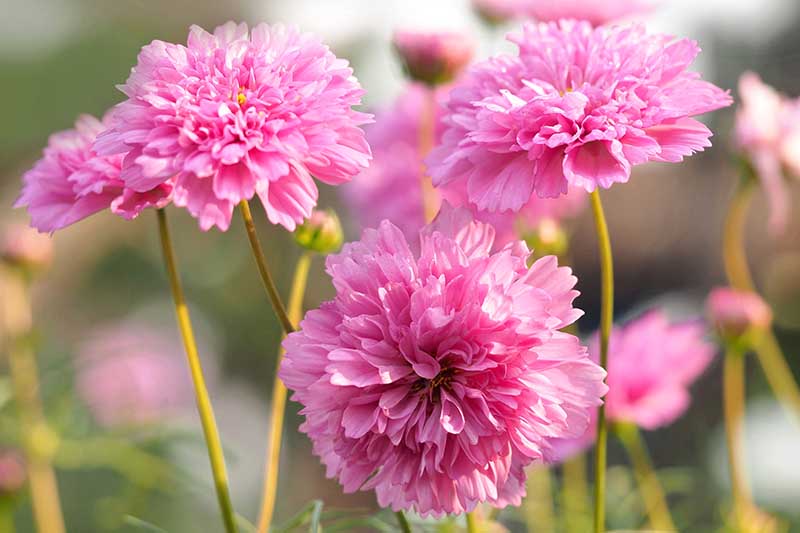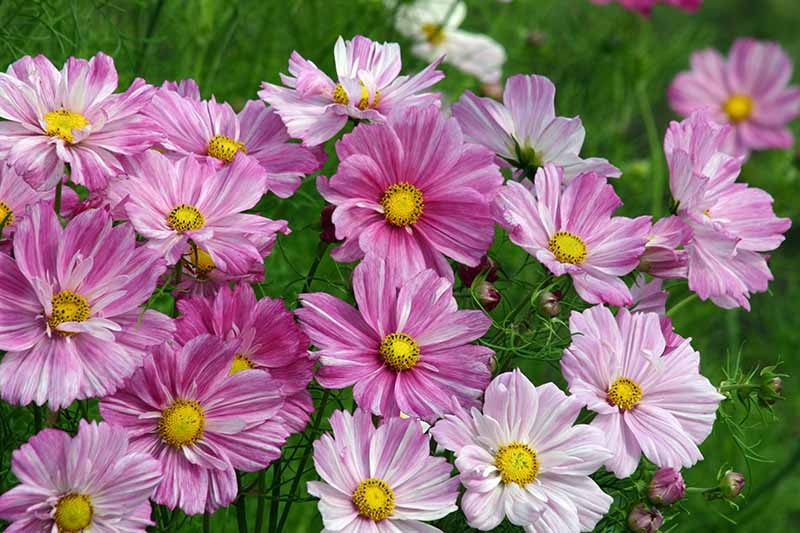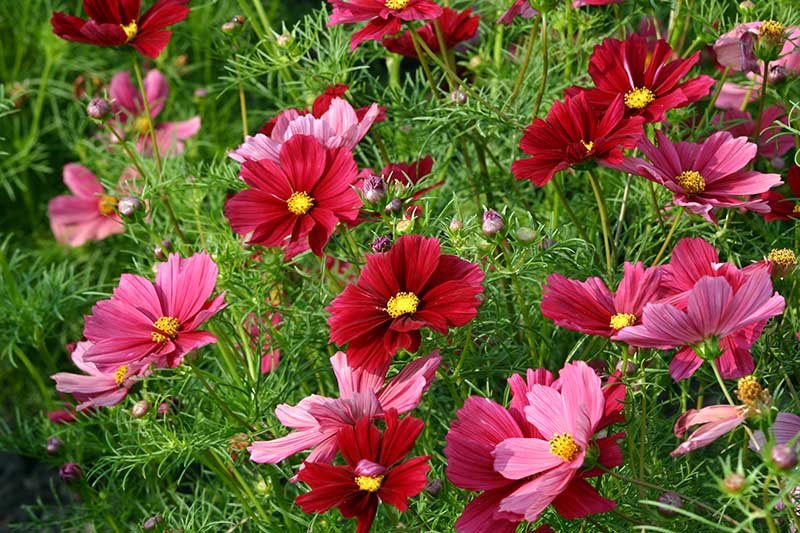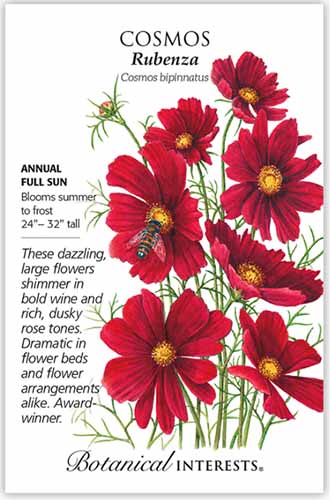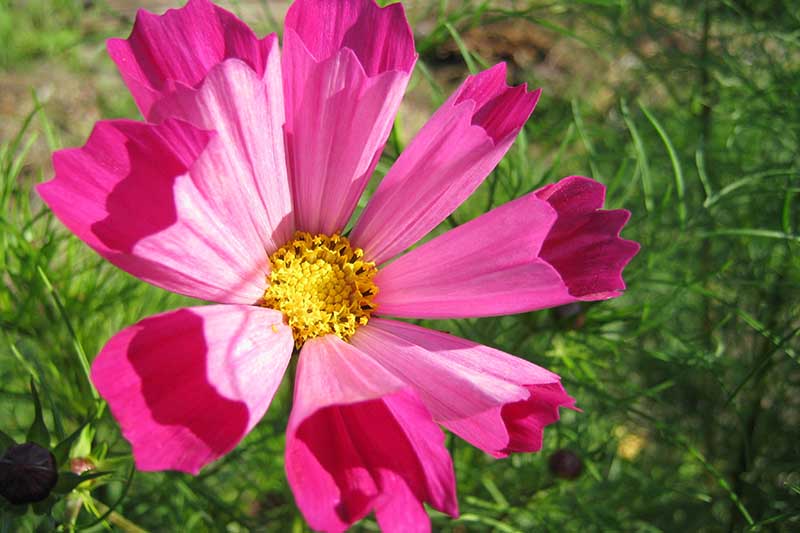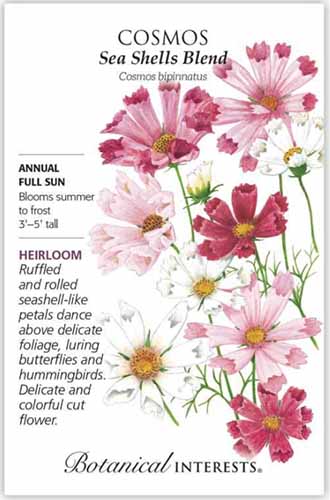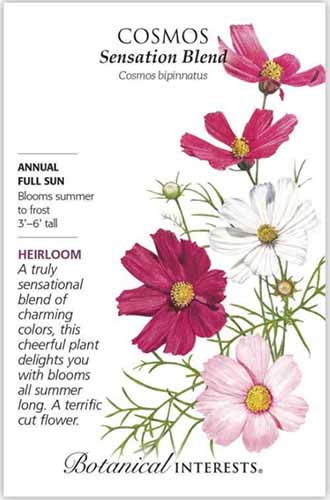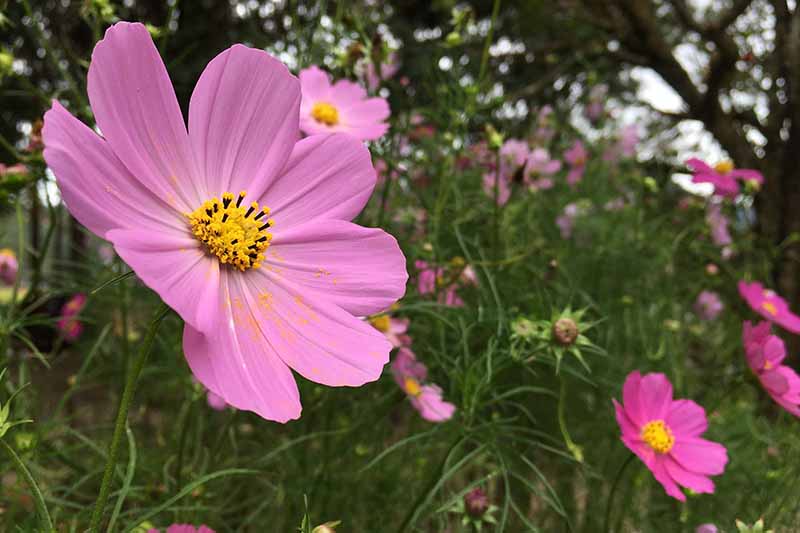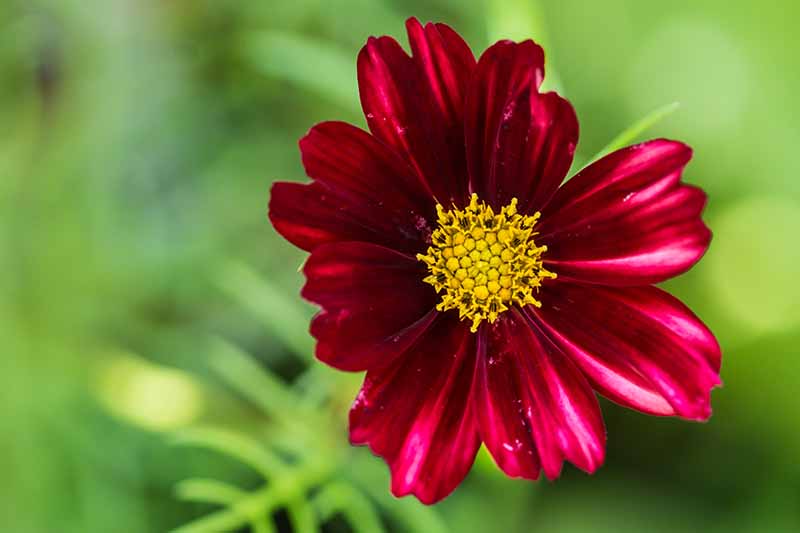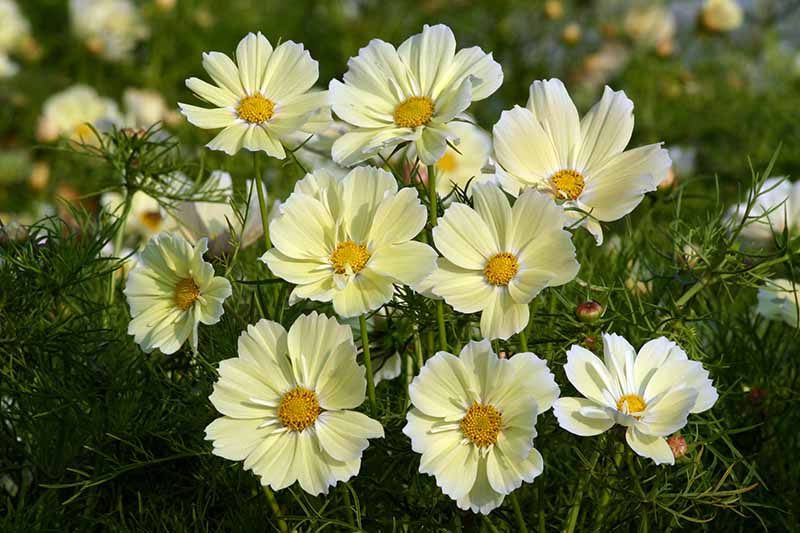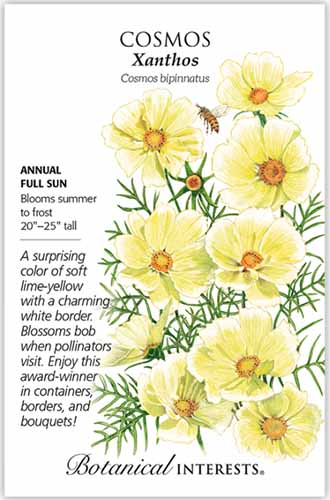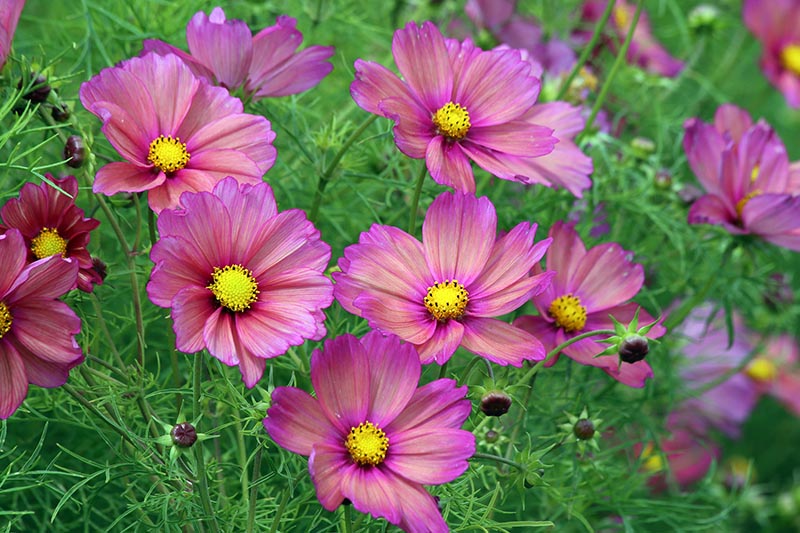These members of the sunflower family attract butterflies, make wonderful companion plants, and will keep blooming up until your first frost, providing wonderful late summer color. And there are many different types of cosmos – not only different cultivars, but different species – giving us even more ways to enjoy them in our gardens. In this article I’ll give you a brief introduction to the main species available to gardeners, and then we’ll get down to business, with a tour of 25 of the best and most beautiful cultivars. We link to vendors to help you find relevant products. If you buy from one of our links, we may earn a commission. I’ll provide you with information on bloom size and plant height for each variety, as well as offering some suggestions on which varieties might pair nicely together. Here’s a sneak peek:
Cosmos Species
Cosmos is a genus in the aster family, Asteraceae, that includes approximately 30 different species. However, only three of these are commonly available for use in brightening our gardens. Let’s have a look at these to see how they differ.
C. atrosanguineus
C. atrosanguineus, also known as chocolate cosmos, is native to northeast Mexico. The flowers of this plant are deep red to chocolatey maroon with matching centers, and they are held on wiry stems. Named not just for its coloring but also for its smell, these richly hued, velvety blooms are scented with a chocolatey fragrance that is more easily discernible on warm days. C. atrosanguineus is compact, growing to be 30 inches tall with an 18-inch spread. It has dark green foliage. Most often found for purchase as a live plant or tuber, this type of cosmos can also be grown from seed. This species requires full sun, does best when grown in well-draining soil that isn’t too rich, and is drought tolerant. Take care not to overfeed or overwater it. It can be treated as a perennial in USDA Hardiness Zones 9 to 11, and possibly in Zones 7 and 8 as well with heavy mulching. For those of us with cold winters, tubers can be dug up in the fall and overwintered indoors, much like dahlias are lifted and stored. In the landscape, uses for chocolate cosmos include borders, butterfly gardens, and flowerbeds.
C. bipinnatus
C. bipinnatus has thread-like foliage that is delicate, fine, and wispy, and is likely the species you are most familiar with. Commonly called “garden cosmos” or “tall cosmos,” this species holds its flowers aloft on delicate, medium green stems. Cultivars of C. bipinnatus abound and are available in shades of white, pink, red, purple, and pale yellow. Their vibrantly colored petals contrast with bright yellow centers. Flower heads range in size from three to six inches wide. Also known as “Mexican aster,” this flowering annual is native to Mexico, but has naturalized in parts of the US and Canada, as well as many other parts of the world. There are many different cultivars of C. bipinnatus, ranging from dwarf varieties that grow to about two feet tall, to lankier types that can grow to be six feet tall or more. C. bipinnatus varieties are often purchased as annual bedding plants from garden centers, but can easily be directly sown into the garden or started indoors as annuals and transplanted out after the last spring frost. They can be grown in Zones 2 through 11. When planting from seed, expect at least 70 days for the first blooms to appear, depending on the cultivar. This species performs best when grown in full sun but can tolerate partial shade – just make sure it receives at least six hours a day of direct sun. C. bipinnatus requires moderate watering but tolerates dry conditions once established. You’ll get more blooms from soil that is not too rich. Mexican asters work well in the landscape when grown at the back of flowerbeds and in borders, and they are also perfect plants to include in less formal “ish” gardens.
C. sulphureus
You might confuse C. sulphureus with marigolds if you take just a quick glance. Like marigolds, the color palette of this species consists of bright yellow, orange, and fiery red, with matching centers. Commonly called “sulfur cosmos,” heads tend to be one to two inches wide. Like C. bipinnatus, this species is native to Mexico and has naturalized in some parts of the United States. It is also known as “orange,” “yellow,” or “klondike” cosmos. Sulfur cosmos cultivars tend to be a bit shorter than those of C. bipinnatus, with most cultivars growing to be one to three feet tall, though some varieties can reach heights of six feet. The foliage of C. sulphureus cultivars is not as fine and wispy as that of garden cosmos and looks more reminiscent of marigold foliage. These plants hold their warm-hued blooms on hairy stems. While sulfur cosmos varieties are frequently found as annual bedding plants at garden centers, they are easy to start from seed, either sown directly in the garden, or started indoors as annuals. They can be grown in Zones 2 through 11. Growing conditions for C. sulphureus are similar to those for C. bipinnatus. These cultivars require at least six hours of direct sun, need well-draining soil, and can handle low to moderate watering. These varieties of cosmos are particularly drought tolerant, making them an excellent choice for xeriscaping. In the landscape, they work well in borders, or as foundation plantings or mass plantings.
1. Apricot Lemonade
With its cool pastel coloring, ‘Apricot Lemonade’ is as refreshing as a cold drink in the heat of summer. This C. bipinnatus cultivar has delicate flowers that open with apricot-colored petals and a lilac blush, then gradually fade to a buttery yellow with a pink blush. Single flowers measure three to four inches across and show a lovely lavender hue on the bottom sides of their petals. ‘Apricot Lemonade’ plants are compact, reaching two to two and half feet tall. They have sturdy stems, making them an excellent addition to your cut flower garden. In 2018, ‘Apricot Lemonade’ won a Fleuroselect Novelty Award, a distinction awarded for innovation in plant breeding. An early variety, you can expect these lovely, bicolored flowers to bloom in 75 to 90 days after sowing. ‘Apricot Lemonade’
2. Bright Lights
I plant cosmos in my garden every year, not just for my own pleasure, but to invite beneficial insects to join in on the fun. If butterflies and bees sound like guests you’d also like to have visit, why not try illuminating their runways with some ‘Bright Lights’? ‘Bright Lights’ is a mix of C. sulphureus blooms that come in shades of yellow, gold, orange, and scarlet. Semi-double blossoms measure two and a half inches across, covering plants that grow to be up to three feet tall. Here’s a design tip – the warm colors of these annuals look gorgeous when grown alongside plants with blue or purple flowers such as borage, chives, or purple asters. ‘Bright Lights’ Do these solar powered “lights” pique your fancy? You’ll find ‘Bright Lights’ available for purchase in one-gram seed packs at Botanical Interests.
3. Candystripe
Sometimes flowers look as sweet as candy, and ‘Candystripe’ is no exception, with its charming bicolored petals. This cultivar of C. bipinnatus has white petals with crimson margins and faint reddish pink stripes. Three- to four-inch single flowers sit atop plants that reach three to six feet tall. ‘Candystripe’ would be stunning grown among some of the white cosmos cultivars included in this selection, or you might let its tall stems become a graceful backdrop to a patch of bee balm. ‘Candystripe’ To give your eyes this sweet treat, you can find ‘Candystripe’ available for purchase in 500-milligram seed packs at Botanical Interests.
4. Choca Mocha
If you like your chocolate dark, perhaps you will enjoy your cosmos dark as well. ‘Choca Mocha’ is a cultivar of C. atrosanguineus, the species that is also known as “chocolate cosmos,” not only for its coloring, but also for its smell. ‘Choca Mocha’ blooms have deep brownish-red petals and dark centers, measure one and a half inches across, and have a chocolatey fragrance. Single blooms grow on petite plants that reach 10 to 12 inches tall. Like other varieties of C. atrosanguineus, ‘Choca Mocha’ is usually propagated from live plants or tubers rather than seeds. ‘Choca Mocha’ ‘Choca Mocha’ is a chocolatey delight that anyone – with or without a sweet tooth – can enjoy. Live plants are available for purchase at Burpee.
5. Cupcake White
When you’re keeping an eye on your dessert intake, you can still enjoy cupcakes – at least, I bet you’ll enjoy this cupcake, a sweet feast for the eyes, if not for the belly. ‘Cupcake White’ is a Mexican aster that has delicate four- to five-inch blooms that look very much like cupcake wrappers – its petals are fused into a lovely chalice shape. Some flowers have additional tufted petals in the centers. These open-pollinated plants are bushy and will grow to be 24 to 36 inches in height. This unique cultivar won a Fleuroselect Novelty Award in 2014. ‘Cupcake White’ If transferring a bit of that snack money into your seed fund seems like a good plan, you’ll find ‘Cupcake White’ available for purchase in packs of 50 seeds at Burpee.
6. Cupcakes and Saucers
Spread out your gingham blanket and open up your picnic basket, it’s time to enjoy ‘Cupcakes and Saucers’ in the garden. A variation on the ‘Cupcake’ variety mentioned above, ‘Cupcakes and Saucers’ is truly out of the ordinary – its outer petals are fused into a chalice shape, but flowers contain frilly petals within the chalice as well. Four-foot plants are bedecked with double and semi-double flowers in shades of white, pink, and lavender, with yellow centers. ‘Cupcakes and Saucers’
7. Daydream
And after a garden picnic, what could be nicer than some al fresco relaxation between the squash vines and bean trellises? To me, the garden seems like the perfect place to kick back and let my mind wander, particularly with a C. bipinnatus cultivar like ‘Daydream’ to keep me company. ‘Daydream’ features petals that are dark pink around yellow centers, gently fading to a paler pink towards the tips. Plants grow to be five to six feet tall and are covered with three-inch flowers. ‘Daydream’ Why not choose this cultivar as a reminder to enjoy your garden for some relaxing? You’ll find ‘Daydream’ seeds available for purchase in a variety of packet sizes at Eden Brothers.
8. Diablo
If you relish hot summer days as much as I do, you might want to add some warm colors to your landscape. ‘Diablo’ is an heirloom variety of sulfur cosmos in a fiery, reddish orange hue that will certainly bring the heat. Taller than ‘Bright Lights’ mentioned above, ‘Diablo’ grows to be four to five feet tall and holds its two-inch flowers on wiry stems. Despite its devilish name, ‘Diablo’ has quite the pedigree, and was named an All-America Selections winner in 1974. ‘Diablo’ Want to pack some visual fire into your landscape design? You can find ‘Diablo’ available for purchase in 500-milligram seed packs at Botanical Interests.
9. Double Click Bicolor Violet
‘Double Click Bicolor Violet’ is a C. bipinnatus variety that you’d be forgiven for mistaking for a carnation. In luscious shades of violet, lavender, white, and cream, these semi-double and double flowers are a riot of ruffles. Open pollinated plants reach 42 to 46 inches tall, and showcase flowers that are two to three inches wide. Flowers bloom in 75 to 90 days after sowing. This Fleuroselect Novelty Award winner from 2016 would look beautiful planted in a bed with drumstick alliums, which will bloom at the same time and can thrive in the same conditions. ‘Double Click Bicolor Violet’ To include this ruffled award winner in your own garden, you can find ‘Double Click Bicolor Violet’ available for purchase in packs of 50 seeds at Burpee.
10. Double Click Cranberries
You may not have the right conditions for growing cranberries in your backyard, but if you live in Zones 2 to 11, you can grow flowers of the same rich hue. ‘Double Click Cranberries’ is a C. bipinnatus variety that comes in a rich burgundy color with double and semi-double blooms. Flowers are two to three inches wide and held aloft on sturdy stems, making this type perfect to use in flower arrangements. ‘Double Click Cranberries’ plants grow to be 42 to 46 inches tall, with flowers blooming 60 to 90 days after sowing. This 2010 Fleuroselect Novelty Award winner will be beautiful in your cottage garden. ‘Double Click Cranberries’
11. Double Take
Some flowers are so mesmerizing you cannot take your eyes off them. Others make you take a second look. I would argue that ‘Double Take’ might cause you to do both. ‘Double Take’ flowers are ivory colored with magenta margins, and blooms are semi-double and double, with frilly petals around yellow centers. The flowers of this C. bipinnatus cultivar are four inches wide, and are held on three- to four-foot plants. ‘Double Take’ Add this looker to your beds as the main attraction – or as a supporting player. ‘Double Take’ would make twice the impact when planted alongside varieties such as ‘Psyche White’ and ‘Rubenza.’ You’ll find ‘Double Take’ available for purchase in packs of 50 seeds at Burpee.
12. Psyche White
Psyche, a figure from Greek Mythology, gives her name to this cultivar. Poor Psyche was so lovely she unwittingly provoked the jealousy – and wrath – of the goddess Aphrodite. But as long as you don’t go around boasting about how beautiful your garden is, you can safely include ‘Psyche White’ in your flowerbeds. (Lesson number one from Greek mythology – never brag.) This captivating white C. bipinnatus cultivar has three- to four-inch double blooms with frilly outer petals and flouncy inner petals around bright yellow centers. ‘Psyche White’ grows to be two to four feet in height, flowering in eight to 12 weeks after sowing. ‘Psyche White’ Include this beguiling cultivar in your garden (preferably without inciting Aphrodite towards acts of vengeance) – you’ll find ‘Psyche White’ available for purchase in packs of 50 seeds at Burpee.
13. Purity
When you’re busy weeding and watering in the heat of summer, you may find yourself dreaming about icicles, snow, and other wintery wonders. Plant ‘Purity’ in your garden, and you’ll be able to rest your eyes on a cooling sight. ‘Purity,’ a variety of C. bipinnatus, has single, white blooms that reach four to six inches in width. Plants grow to be three to four feet tall, and provide a mass of white flowers in 75 to 90 days after sowing. ‘Purity’ Want to grow some simple visual refreshment in your landscape? You’ll find ‘Purity’ seeds available in an assortment of pack sizes at Eden Brothers.
14. Radiance
When it comes to flowers, I am an equal opportunity admirer – I appreciate over the top prettiness as much as more subtle floral beauty. ‘Radiance’ falls into the latter category – it is striking, but in a more subdued way. An open-pollinated heirloom variety of C. bipinnatus, ‘Radiance’ has single flowers that are a deep magenta around yellow centers, radiating out to a rosy pink along its petals. Plants reach three to five feet in height and are covered profusely in three- to four-inch flowers, starting 60 to 90 days after sowing. ‘Radiance’ won the All-America Selections award for flowers in 1948. ‘Radiance’ Allow this radiant beauty into your summer garden – you can find ‘Radiance’ seeds available for purchase in a selection of pack sizes at Eden Brothers.
15. Rose Bon Bon
While ‘Radiance’ may be an understated beauty, ‘Rose Bon Bon’ takes its prettiness over the top. This rose-colored cultivar of C. bipinnatus has all the subtlety of a multi-layered, ruffled, pink prom dress – that is to say, none at all. Yet it is charming nonetheless, with its curled petals and double blooms, looking much like a carnation. Three-inch flowers grow on plants that reach three to four feet tall. ‘Rose Bon Bon’ has long stems, making these exquisite rose-hued blooms perfect for vases. And they’ll be ready to cut in 60 to 90 days after sowing. ‘Rose Bon Bon’ Sometimes over the top prettiness is just what you need to lift your spirits. If you agree, you’ll find ‘Rose Bon Bon’ seeds available for purchase in packets that will cover up to 80 square feet at Eden Brothers.
16. Rosetta
I’m firmly convinced that gardening can help one stay focused on the important things in life. It’s almost as if there were important messages to be found in the flower petals. Without the help of any stones, I deciphered what ‘Rosetta’ told me: “Relax, smell the roses, and fill your life with flowers.” ‘Rosetta,’ a bicolor C. bipinnatus cultivar, has delicately striped petals in white and blushing shades of pink. Plants reach 25 to 32 inches tall and are loaded with large, four-inch, single and semi-double flowers. This beautifully patterned early variety needs just 80 days from sowing to flowering. It won a Fleuroselect Novelty Award in 2016. ‘Rosetta’ Invite ‘Rosetta’ into your garden. Maybe she has messages for you, too. You’ll find ‘Rosetta’ available in packs of 50 seeds at Burpee.
17. Rubenza
‘Rubenza’ is a C. bipinnatus cultivar that brings to mind the deep red accent color in works by the Flemish painter, Rubens. Single, three-inch blooms start out a shade of ruby red and as time passes, they fade to a lovely shade of antique rose. Open pollinated plants reach 24 to 32 inches tall and are early to bloom, opening their first buds in 75 to 90 days. Rubenza is a double winner, with a Fleuroselect Novelty Award from 2008 under its leafy belt, as well as an Award of Garden Merit from the Royal Horticultural Society from 2016. ‘Rubenza’ Want to bring an artistic palette to your flowerbed? You’ll find ‘Rubenza’ available for purchase in 300-milligram seed packs at Botanical Interests.
18. Sea Shells
We all know she sells seashells by the seashore – but she might have sold even more if she’d had these particular ‘Sea Shells.’ A truly exceptional heirloom C. bipinnatus variety, ‘Sea Shells’ has tubular petals. ‘Sea Shells’ is a mix, with flowers in shades of white, pink, rose, and crimson. Blooms are two and a half to three inches across on plants that grow to be three to five feet tall. ‘Sea Shells’ may take a bit longer to reach maturity compared to some of our other selections – allow 90 to 110 days from sowing for the first buds to burst. ‘Sea Shells’ If you’re ready to shore up your own ‘Sea Shells’ collection, you’ll find organically grown or conventional seeds available for purchase in 500-gram packs at Botanical Interests.
19. Sensation Blend
It won’t take much work to create a ‘Sensation’ in your neighborhood with this knockout blend. The open-pollinated ‘Sensation’ mix features single flowers in gorgeous shades of white, pink, rose, and crimson. Requiring 75 to 90 days from seed to flower, these plants can grow to be quite large, between three to six feet in height, and are topped with lovely three- to four-inch blooms. ‘Sensation,’ a cultivar of C. bipinnatus, was the All-America Selections Winner in the flower category in 1936. ‘Sensation’ Blend Don’t be surprised if all your neighbors are asking about your beautiful flowerbeds with this mix. You’ll find conventional and organically grown ‘Sensation Blend’ seeds available at Botanical Interests.
20. Sonata Mix
Can you hear that? That’s the sound of ‘Sonata’ bobbing in the breeze. These lovely flowers have all the elegance of a musical composition. ‘Sonata’ is an open-pollinated C. bipinnatus variety that won the Fleuroselect Novelty Award in 1991. Single flowers with wide petals come in shades of white, rose, pink, and cherry. These compact plants grow to be 20 to 24 inches tall and are covered with flowers that are two and a half to three inches wide. ‘Sonata’ Mix To tune your yard with the delights of the ‘Sonata’ mix, you can find seeds available for purchase at Burpee.
21. Velouette
If you find bicolored cosmos flowers enthralling, you may not be able to turn away from these eye-catching beauties, since each bloom is as unique as a work of art. ‘Velouette’ offers an assortment of single, velvety flowers – some are white with deep red stripes, others are dark red with faint white striping, and still others have petals whose stripey patterns lie somewhere in between. Yellow centers stand out among these striking petals. An early flowering C. bipinnatus cultivar, ‘Velouette’ will show its first color in as little as 70 days. Plants grow to be 25 to 32 inches tall and are covered with large flowers. This cultivar won a Royal Horticultural Society Award of Garden Merit in 2016. ‘Velouette’ looks stunning when planted with fellow RHS winner ‘Rubenza.’ ‘Velouette’ If you’re ready to fill your flowerbeds with these stripey masterpieces, you’ll find ‘Velouette’ available in packs of 50 seeds at Burpee.
22. Versailles Tetra Red
In a shade as deep as a fine French wine, ‘Versailles Tetra Red’ will conjure up the regality of the famous Parisian chateau it takes its name from. Single, burgundy-colored flowers measure two and a half inches across on plants that can grow up to four feet tall. An open pollinated C. bipinnatus cultivar, ‘Versailles Tetra Red’ will begin to bloom 60 to 90 days after sowing. This variety makes an excellent cut flower for use in arrangements. ‘Versailles Tetra Red’ Make a rendezvous with your own French royalty. ‘Versailles Tetra Red’ seeds are available for purchase at Eden Brothers.
23. White Knight
Does your garden need a champion to bring in a little adventure? This ‘White Knight’ comes wearing ruffles. ‘White Knight’ is a C. bipinnatus cultivar in the Double Click series with ruffled, semi-double to double creamy white flowers that measure two and a half to three inches across. Plants grow to be three feet in height and produce flowers in 60 to 90 days. For a stunning display of all white blooms, try combining ‘White Knight’ with our other white selections, ‘Purity,’ ‘Psyche White,’ and ‘Cupcakes’ ‘White Knight’ Life (in the garden, at least) will never be boring with this extravagant white cultivar. You’ll find ‘White Knight’ seeds available for purchase in packets that will cover up to 80 square feet at Eden Brothers.
24. Xanthos
In addition to lessons about jealousy and humility, as seen with Psyche above, Greek mythology is also known for its stories of humans being transformed into flowers. You may remember the famed Narcissus who gave his name to the flower we also call daffodil. So when I look at ‘Xanthos,’ which means “blond” or “yellow” in Greek, I can’t help imagining a little blond head bobbing in the breeze, transformed by some jealous god or goddess. ‘Xanthos’ is a C. bipinnatus cultivar with lovely, pale yellow flowers that are on the small side, at two to two and a half inches across. A dwarf variety, ‘Xanthos’ won a prestigious Fleuroselect Gold Medal Award in 2016 for its “beauty, innovation, use, and garden performance.” It grows to two feet tall and makes a great choice for container gardening. And making it even more attractive, it flowers in just 70 days after sowing. ‘Xanthos’ Why not plant ‘Xanthos’ along with ‘Psyche White’ and let these two keep each other company? You’ll find ‘Xanthos’ available for purchase in packs of 25 seeds at Botanical Interests.
25. Xsenia
Just like the pronunciation of its name, the color of this C. bipinnatus cultivar may leave you guessing. The bicolored petals of ‘Xsenia’ might be described as terra cotta with rose colored margins – but these flowers seem to change color depending on the time of day. In 75 to 90 days after sowing seeds, ‘Xsenia’ will produce two and a half- to three-inch blooms on plants that grow to be 24 to 28 inches tall. ‘Xsenia’ won a Fleuroselect Novelty Award in 2018. Try planting ‘Xsenia’ along with ‘Apricot Lemonade.’ The terra cotta and apricot tones of these two extraordinary cosmos varieties will complement each other nicely. ‘Xsenia’
A Universe of Cosmos Choices
With all these cosmos choices, you’re bound to find one or two cultivars you love. As for me, when it comes to picking a favorite, I’m at a loss – they’re just all too lovely. However, since I can’t plant them all at once (yet), this year I’m including ‘Velouette,’ ‘Candystripe,’ ‘Rosetta,’ and ‘Sea Shells’ in my own garden landscape. I just can’t wait to see those lovely flower heads bobbing in the breeze, attracting the attention of bees, hummingbirds, and of course, myself. Which varieties are your favorites? Are you envisioning any spectacular combinations among these cultivars? Let me know in the comments section below. Now that you know which fantastic cosmos varieties you want to plant in your yard, feel free to give yourself a refresher on the best growing techniques with our complete cosmos growing guide. And if you’re looking for some other flowering annuals to include with your cosmos, be sure to check out our growing guides for these other garden flowers next:
How to Harvest and Save Cosmos SeedHow to Grow and Care for Dianthus FlowersSnapdragon Is the Perfect Cutting Garden Annual

